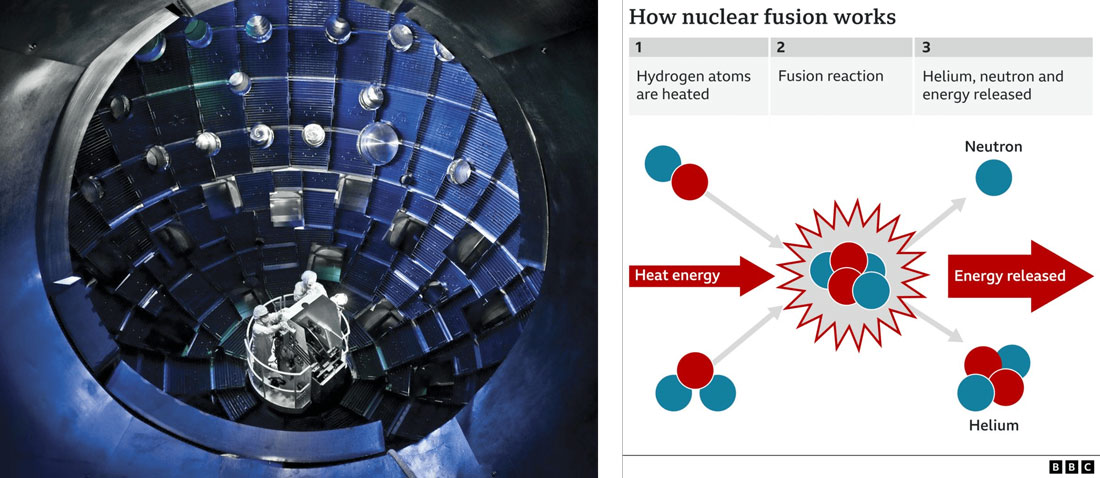
Expeditions in Education: Dacia and Steve Jones
December 21, 2022
Monthly Newsletter – January 2023
January 12, 2023(Image source: BBC)
Just last month, on December 5, 2022, scientists at Lawrence Livermore National Laboratory fired up a series of 192 ultraviolet lasers pointed at a peppercorn-sized sample of hydrogen encased in diamond. All with the goal of producing a nuclear fusion reaction resulting in a net energy gain … and it worked!
Nuclear Fusion
Nuclear fusion is a process in which two or more atoms combine to form one or more heavier atoms. If you’re looking for an example of this phenomenon in nature, just look up at the Sun! (Just kidding. Don’t actually look up directly at the Sun without eye protection. Bad idea.) Our Sun, just like every other star we see in the night sky, is just one big, continuous fusion reaction. Thanks to the immense temperatures and pressures present in its core, the Sun is able to fuse hydrogen atoms together to form helium, releasing light and heat as a result. This is the beauty behind nuclear fusion; it’s literally a way of turning matter into energy.
Since the discovery of nuclear fusion in the cores of stars back in the 1930s, it’s been the dream of scientists and engineers alike to harness this phenomenon as an efficient and clean method of generating power down here on Earth. Believe it or not, scientists have been making fusion happen in controlled laboratory settings since the late 1950s, but these laboratory fusion reactions were never able to break even in terms of energy production; the amount of energy produced by the fusion reaction was always less than the amount of energy needed to initiate the process.
The Fusion Breakthrough
This is what makes the recent breakthrough at Lawrence Livermore’s National Ignition Facility (NIF) so monumental. The NIF is a $3.5 billion laser complex the size of a football stadium where scientists have been hard at work to bring the power of the stars into human hands. Just like the core of our Sun, the NIF’s reactor is able to achieve nuclear fusion via extremely high temperatures and pressures. Inside the reactor, temperatures climb up to 180 million degrees Fahrenheit (hotter than the center of the Sun) and pressures reach up to 100 billion times that of Earth’s atmosphere. The experiment goes a little something like this:
- Step 1: Shoot laser beams at hydrogen sample encased in diamond
- Step 2: Laser beams hit small gold cylinder surrounding hydrogen sample and create X-rays
- Step 3: X-rays vaporize diamond coating surrounding hydrogen sample and create shockwaves
- Step 4: Shockwaves crush hydrogen sample and force hydrogen atoms to fuse into helium atoms
The result? An output of 3.15 megajoules of energy in the form of heat (equivalent to about three sticks of dynamite). Given that only 2.05 megajoules of energy were needed to start the reaction (in the form of the light from the ultraviolet lasers), this was the first time in history that scientists successfully got more energy out of a laboratory fusion reaction than what they put into it.
The Future of Fusion
So what does this breakthrough really mean for the world? In short, a lot. Even with the recent accomplishments at the NIF, fusion reactor technology is still in its infancy. But future research into this technology could mean abundant, clean energy for the entire world – an especially big win when it comes to the subject of climate change. Think about it. No more pollution or greenhouse gas emissions from fossil fuels. No more dangerous radioactive waste from nuclear power plants (which use nuclear fission to generate power as opposed to nuclear fusion). Over the next few decades, the challenge for scientists and engineers will be to refine this technology, making the reactions sustainable for longer periods of time and scalable so that one day entire power grids can be energized via fusion reactors.
If you’re interested in hands-on STEM education with a focus on renewable energy, be sure to check out our Horizon Educational products! In lieu of bringing a nuclear fusion reactor into the classroom (bummer, I know), these kits give students the opportunity to explore concepts like wind energy, solar energy, and even hydrogen fuel cells!
Let’s see what the future holds. Until next time.
— Dr. Jake Roark




